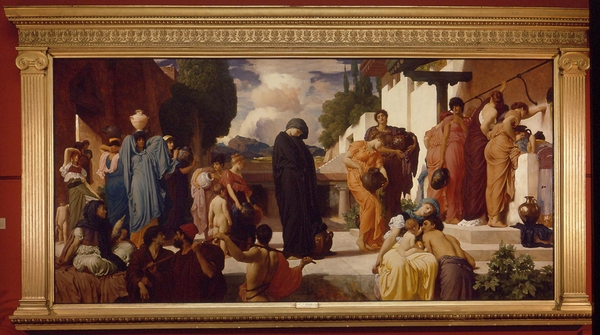Captive Andromache
Lord Frederic Leighton 1830 - 1896
Summary
Girls and women dressed in flowing drapery process from the left along a raised stone walkway on their way to collect water from a high rectangular well on the right. In the centre stands Andromache, a woman draped in black, her face, neck and foot just visible. She looks pensively towards a family group at the bottom right, where a baby sits on its mother’s knee and touches its father’s face. To the front left are two men in deep maroon robes holding wooden staffs, one of whom wears a red cap and gestures with his thumb towards Andromache. A partially draped man in the foreground with his back to the viewer also carries a staff and looks towards her. In the bottom left corner sits an old woman who is spinning. She too gazes at Andromache. A mountainous landscape framed by trees is visible behind Andromache. White turbulant clouds fill the sky immediately behind her head. White stone buildings are behind the women to the right, and dark stone buildings behind the women to the left, where there is a sunlit gateway through which they enter. The women on the right are dressed in shades of peach, pink and maroon. The women to the left are dressed mostly in blue, green and purple and are accompanied by younger girls, and two small nude children. The women carry Greek-style water pots. The gilt frame has a fluted ionic column on either side. Along the top is a joined-up sprig design with a row of beading either side. On the lower edge is a row of large oval beading.
Display Label
Gallery text panel In Pursuit of Beauty Late Victorian Art and Design Improving the quality of British art and design had been a concern since the 1850s. The British Empire had expanded into new continents but it was the classical ideal of beauty, based on Ancient Greek and Roman culture that was still considered the model for serious art. The pursuit of beauty was a form of escapism from the mass-production of industrial Britain. As well as looking to the ancient world, artists and designers were delighted and inspired by the arts of Renaissance Italy, the Middle and Far East. Many of the paintings here feature a beautiful woman. Sometimes she is a passive, decorative form, but often she is a dark and brooding femme fatale, a symbol of seduction, deception and destruction. The 'fatal woman' may reflect late Victorian male fears as women campaigned for equal rights and new roles. The emphasis on colour, harmony and rhythm and simplifying the form of an object would become major concerns in the 20th century. They can be seen emerging here in the work of late Victorian artists and designers.
Object Name
Captive Andromache
Creators Name
Date Created
1888 (circa)
Dimensions
Canvas: 197cm x 407cm
Frame: 236cm x 468cm
accession number
1889.2
Place of creation
England
Support
canvas
Medium
oil paint
On Display
[G10] Manchester Art Gallery - Gallery 10
View all
Credit
Purchased with the assistance of The Friends of Manchester City Galleries.
Legal
© Manchester Art Gallery


